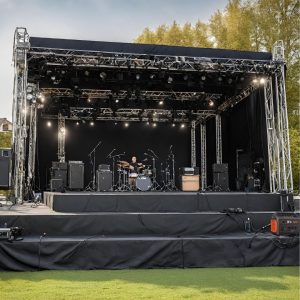Can I Use a Jackery to Power Stage Lighting? Explained

If you’re involved in stage lighting, you know how important it is to have reliable power sources. Without them, your lighting equipment won’t function properly, and your performance will suffer. You may be wondering if you can use a Jackery power station to power your stage lighting. The answer is yes, but there are some important things you need to know.
First, let’s talk about what a Jackery power station is. It’s essentially a portable battery pack that can be used to charge and power a variety of electronic devices and appliances. Jackery power stations come in different sizes, from compact models that can fit in your pocket to larger models that can power your entire home. They have a variety of ports, including standard AC outlets, USB and USB-C outlets, and DC ports.
Now, let’s talk about stage lighting fundamentals. Stage lighting typically requires a lot of power, so you’ll need to make sure your Jackery power station is up to the task. You’ll also need to consider the type of lighting you’re using, as different types of lighting require different amounts of power. Finally, you’ll need to make sure you have the right cables and adapters to connect your lighting equipment to your Jackery power station.
Key Takeaways
- Jackery power stations can be used to power stage lighting, but you need to make sure you have the right size and type of power station for your needs.
- Stage lighting requires a lot of power, so you need to make sure your Jackery power station is up to the task.
- You’ll also need to make sure you have the right cables and adapters to connect your lighting equipment to your Jackery power station.
Understanding Jackery Power Stations
If you’re looking for a portable power source for your stage lighting, a Jackery power station might be a good option. Jackery power stations are essentially large rechargeable battery packs that can power a variety of electronic devices and appliances.
Capabilities and Limitations
Before selecting a Jackery power station, it’s important to understand its capabilities and limitations. Jackery power stations are powered by lithium-ion batteries and are available in different capacities, measured in watt-hours (Wh). The capacity of a Jackery power station determines how much power it can provide, and how long it can provide power for.
Jackery power stations have a limited number of charge cycles, meaning that they can only be charged and discharged a certain number of times before their capacity begins to degrade. It’s important to keep this in mind when selecting a model, as you want to choose one that will last for multiple charge cycles.
While Jackery power stations are a convenient and portable power source, they do have their limitations. They cannot power high-wattage devices such as air conditioners or refrigerators, and their capacity may not be enough to power all of your stage lighting for an entire performance.
Selecting the Right Model
When selecting a Jackery power station for your stage lighting, it’s important to consider the power requirements of your lighting equipment. You’ll want to choose a model with a capacity that is sufficient to power your lights for the duration of your performance.
The Jackery Explorer 500, Explorer 240, and Explorer 1000 are all popular models for powering stage lighting. The Explorer 500 has a capacity of 518Wh, the Explorer 240 has a capacity of 240Wh, and the Explorer 1000 has a capacity of 1002Wh.
Aa Jackery power station can be a useful and portable power source for your stage lighting. However, it’s important to choose the right model with a sufficient capacity and to keep in mind its limitations.
Stage Lighting Fundamentals
When it comes to stage lighting, there are a few fundamental concepts you should be familiar with. In this section, we’ll cover the types of stage lights and the electrical requirements needed to power them.
Types of Stage Lights
There are several types of stage lights, each with its own unique purpose.
- Spotlights are used to highlight a specific performer or area of the stage. They produce a narrow, focused beam of light that can be adjusted to suit the needs of the performance.
- Wash lights are used to illuminate a large area of the stage. They produce a broad, even beam of light that can be used to create a general mood or atmosphere.
- Gobos are patterns or designs that are projected onto the stage. They can be used to create a specific mood or to add visual interest to the performance.
- Ellipsoidal and reflector spotlight are used to focus light on a specific area of the stage. They produce a sharp, well-defined beam of light that can be used to highlight a performer or prop.
- Fresnel and reflector are used to fill a large area of the stage with light. They produce a soft, diffused beam of light that can be used to create a general mood or atmosphere.
Electrical Requirements
When it comes to powering your stage lights, there are a few things you need to consider.
- Wattage is the amount of power a light consumes. You’ll need to make sure your power source can handle the wattage requirements of your lights.
- Power consumption is the amount of power your lights will consume over time. You’ll need to make sure you have enough power to keep your lights running for the duration of your performance.
- Volts are the amount of electrical pressure needed to power your lights. You’ll need to make sure your power source provides the correct voltage for your lights.
- LED lamps are becoming more common in stage lighting. They consume less power and produce less heat than traditional lamps, making them a more energy-efficient choice.
To power your stage lights using a Jackery power station, you’ll need to make sure the station can handle the wattage and voltage requirements of your lights. You’ll also need to consider the power consumption of your lights and make sure you have enough battery life to last the duration of your performance. A lighting controller can help you manage the power consumption of your lights and ensure they’re running efficiently.
Overall, with the right planning and preparation, a Jackery power station can be a reliable and convenient way to power your stage lights.
Powering Stage Lighting with Jackery
If you’re looking to power your stage lighting with a portable power station, Jackery is a great option. With a variety of output power options and portable sizes, Jackery power stations can be a convenient and reliable way to illuminate your stage.
Connecting and Setup
To power your stage lighting with a Jackery power station, you will need to connect it to the lighting equipment. First, ensure that your Jackery power station is fully charged. You can charge it using a wall outlet, car outlet, or a third-party solar panel. For the E1000 and lower models, the panels must output 12V-30V and have the correct connection plug (7.9mm5.5mm0.9mm). For the E1500 or higher, the panels must output 12V-51V and have the correct connection plug (8.0mm5.5mm2.0mm).
Once your Jackery power station is charged, connect it to your lighting equipment using the appropriate cables. Make sure to check the voltage and plug connection size of your equipment to ensure compatibility with your Jackery power station.
Safety and Best Practices
When using a Jackery power station to power your stage lighting, it’s important to follow some safety and best practices. First, make sure to use a quality Jackery power station and accessories to ensure safe and reliable operation. Avoid using damaged or outdated equipment.
Additionally, make sure to cycle your Jackery power station regularly to maintain its battery life. Avoid exposing it to extreme temperatures or shading, which can affect its performance.
Finally, always follow proper stage lighting setup and installation procedures to ensure the safety of your performers and audience. Make sure to highlight key areas of the stage, such as the speaker and musicians, and adjust the intensity of your lights as needed. Consider using a mix of moving lights, lanterns, floodlights, and other equipment to create a dynamic and engaging performance.
By following these tips and using a reliable Jackery power station, you can power your stage lighting with ease and confidence.
Frequently Asked Questions
How long can a Jackery unit typically power stage lighting equipment?
The run time of a Jackery unit for stage lighting equipment depends on the wattage of the lighting system and the capacity of the Jackery unit. Typically, a Jackery unit can power a small stage lighting system for several hours, while a larger lighting system may require a higher capacity unit or multiple units.
What is the maximum wattage a Jackery portable power station can handle for lighting systems?
The maximum wattage a Jackery portable power station can handle for lighting systems varies depending on the model. The Jackery Explorer 1000, for example, can handle up to 1000 watts of continuous power, while the Jackery 2000 can handle up to 2000 watts.
Can a Jackery be recharged with solar power while simultaneously powering stage lights?
Yes, a Jackery can be recharged with solar power while simultaneously powering stage lights. However, the recharge rate will depend on the size and efficiency of the solar panel being used.
What are the run time capabilities of a Jackery Solar Generator for continuous stage lighting use?
The run time capabilities of a Jackery Solar Generator for continuous stage lighting use depend on the wattage of the lighting system and the capacity of the generator. A Jackery Solar Generator with a capacity of 1000Wh can power a 200W lighting system for up to 5 hours, while a 500W lighting system can be powered for up to 2 hours.
How does the Jackery 2000 model perform with high-demand stage lighting setups?
The Jackery 2000 model is designed to handle high-demand stage lighting setups and can provide up to 2000 watts of continuous power. However, the run time will depend on the wattage of the lighting system and the capacity of the Jackery unit.
What are the charging times for various Jackery models when powering stage lighting?
The charging times for various Jackery models when powering stage lighting will depend on the size of the Jackery unit and the charging method being used. For example, the Jackery Explorer 1000 can be fully recharged in 8 hours using a wall outlet, while the Jackery 2000 can be fully recharged in 4.5 hours using a wall outlet. Charging times may be longer when using solar panels for recharging.
Related Articles in Jackerys for Entertainment and Outdoor Events
Best Jackery for Outdoor Parties
Can a Jackery Run a Blender?
Highest Rated Jackery for Tailgating
Jackery to Power Projector Outside
How Long Will a Jackery Run a TV?
Jackery for Bounce House
Quiet Event Power Station
Backup Power for Catering Equipment
Jackery Size for Food Truck




